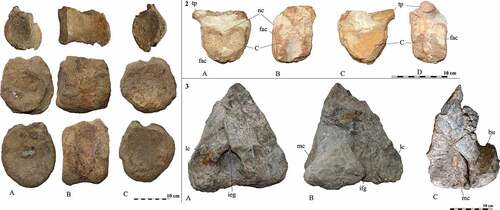Figures & data
Figure 1. Regional geological map of the Cabo Espichel area with relevant location of the studied site and the limits between deposits of the Mesozoic cropping out in the area: A - Portuguese Mesozoic formations; B - Mesozoic formations of Lisbon and Setúbal peninsulas; C - Geology of Cabo Espichel area; D – Chronostratigraphic sequence of the Lower Cretaceous geological formations of Espichel, the Papo-Seco Formation is highlighted in green; E - Localization of the Paleontological sites Boca do Chapim, Praia do Areia do Mastro and Praia do Guincho in an image of Google Earth. Scales: A - 20 km; B - 10 km; C - 2 km.
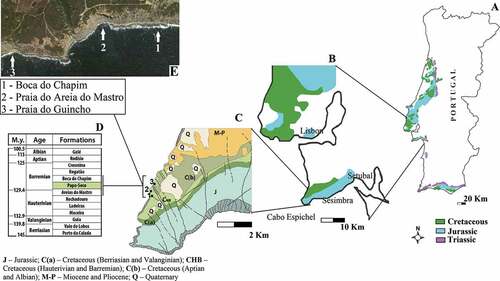
Figure 2. Lithostratigraphy of the Praia do Areia do Mastro site. A - Stratigraphic column and legend: 1 – sandstone; 2 – marl; 3 – limestone; 4 – lamination; 5 and 6 – vertebrates fossils (5 – footprints; 6 – bones and teeth); 7 – bivalves; 8 – gastropods. Codes: U – lithostratigraphic unit; T – thickness; B – bed reference; L – Lithology; F – fines; S – sand; G – gravel; AM – Areia do Mastro Formation; PS – Papo-Seco Formation. (Adapted from Figueiredo et al. Citation2022). B – Praia do Areia do Mastro outcrop, with the area of the Papo-Seco Formation on the stratigraphic column marked by a black rectangle.
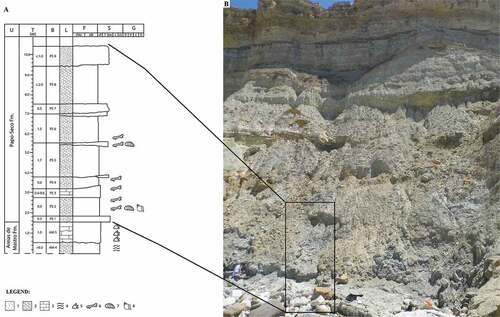
Figure 3. Isolated teeth of Ornithopoda indet. from the Papo-Seco Formation of Portugal. Dentary teeth MG8760 (A) and MG10 (B); maxillary tooth CPGP.1.03.3 (C). Scale: 2 cm.
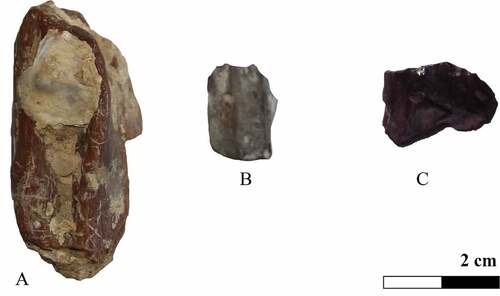
Table 1. Ornithopods from the Lower Cretaceous (Barremian) of the Papo Seco Formation - Cape Espichel, Portugal.
Table 2. Measurements of the ornithopod teeth from the Papo-Seco Formation referred in this study. Abbreviations: LApex – Apex Length; Wapex - Apex Weight; CH - crown height; H-Wr -Height-to-width ratio; CBL - crown base length; MW - mesiodistally width; RCH/MW: ratio crown height/mesiodistally width.
Figure 4. Isolated teeth of Iguanodontia indet. from the Papo-Seco Formation of Portugal. Dentary teeth MNHNUL.DIN.002 (A-C) and MNHNUL.DIN.003 (D-G): A and D – labial surface; B and E - posterior surface; C and F- lingual surface. G – Illustration of Lapparent & Zbyzsewski (Citation1957) with complete tooth MNHNUL.DIN.003. Maxillary tooth MG4744 (H, I J): H - labial surface; I - lingual surface; J - posterior surface. Maxillary tooth CPGP.1.18.44 (L-N): L - labial surface; M - lingual surface; N - posterior surface. Maxillary tooth CPGP.1.01.1 (O-Q). O – labial surface; P - lingual surface; Q - posterior surface Abbreviations: d – lingulate denticles; eb – enamel border; irs – inter-ridge surface; mde – marginal denticles; Nc – neck; pr – primary ridge; sr – secondary ridges. Scale: 2 cm
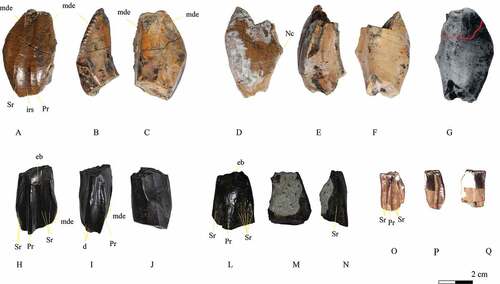
Figure 5. Maxilla fragment of Iguanodontia indet. CPGP.1.99.7. A - lingual view; B - buccal view (inverted image); C - buccal view of crown 4; D - dorsal view of crown 4; E and E - buccal views of crown 5. Abbreviations: Form – foramina; m - mammilla; mde - marginal denticules; Pr - primary ridge; Sr - secondary crown ridges. Scales: A and B - 2 cm; C to F - 1 cm.
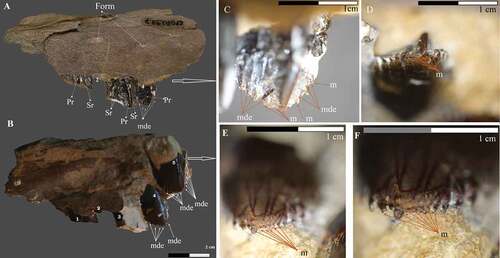
Figure 6. Partial skeleton CPGP.02.07.1 provisionally referred to Ornithopoda indet. Representation of some of the material already restored (A - one of the four caudal vertebrae, B - dorsal rib, C - neural spine, D - haemal arch, E – ischium, F – phalanx) and its localization on an ornithopod skeleton
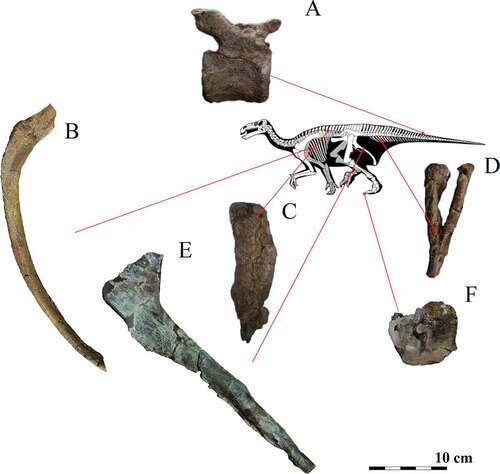
Figure 7. Vertebral remain (prezygapophysis) of Ornithopoda indet. CPGP.3.13.5a. A and C – lateral views; B – anterior view.

Figure 8. Indeterminate ornithopod bones: A – MG 8761; B to D – MG 8759.3; E – MG 4739; F – MG 17). G – Label of one of the unpublished specimens of Museu Geologico (MG 8761) with the identification “Iguanodon” and Boca do Chapim.
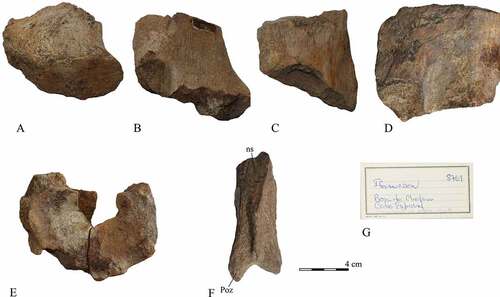
Figure 9. Axial and appendicular skeleton remains: 1 and 2 - caudal vertebrae of Iguanodontoidea indet.: 1 - MG4741 (above). MG 13.2 (middle) and MG 13.1 (down). A – cranial view; B – lateral view; C – caudal view; 2 - CPGP.1.14.18. A- cranial view; C- caudal view; B and D – lateral views. Abbreviations: C – centrum; fac – articular faces; nc – neural channel; tp – transverse process; 3 - Femur of Iguanodontoidea indet. MG4740 A – cranial view; B – caudal view; C – Medial view. Abbreviations: bu: buttress; ieg: intercondylar extensor groove; ifg: intercondylar flexor groove; lc: lateral condyle; mc: medial condyle.
